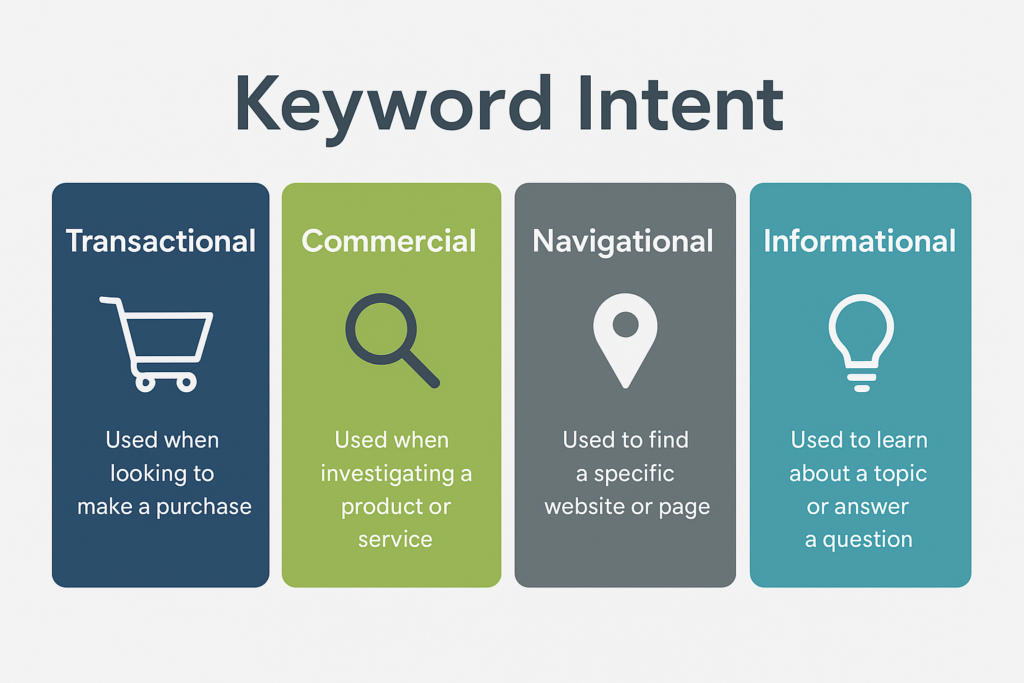What Is Search Intent?
What is search intent and how does it play into your SEO strategy? Search intent can loosely be defined as the goal a web searcher is trying to achieve when using search engines to find something, whether it’s entertainment options, product information, where to purchase a product they know they need or find a specific location, among other things.
Long ago when the internet was still new and SEO was simpler, search visibility strategy was to show up for the keywords and phrases that exactly described what you were selling with the assumption that searchers would click to your site and buy directly from you or email/call you to learn more about your services and products.
However, as the internet became more functional and buyers became more comfortable with making online decisions, they required detailed information to trust the online buying process. Marketers learned what the buyer’s journey looked like for their websites and in that process, discovered that generic, high level keywords and phrases weren’t enough to increase conversions. Let’s look at what search(er) intent is and how to optimize for it.
4 Types Of Search Intent
There are four main search intent types, with many sub-types. If you’re new to combining search intent with keyword research, keep it simple. The high level categories are:
Transactional keywords – these are phrases searchers type in when they’re ready to purchase products and services. They’ve done their homework and have made their decision on the specific products/services they’re ready to spend money on.
- asus tuf gaming laptop
- womens Merrill waterproof hiking boots size 8
Commercial intent keywords – these phrases reflect searchers doing their homework on what options are available before they buy
- golf clubs for beginners
Navigational search intent – when the searcher is looking for a website or specific webpage
- edmunds blue book
- Synology NAS download page
Informational search intent – searchers are looking for pages to learn about a topic or to solve a problem
- How to replace a window screen
By the way – if you’re interested in getting your content featured in AI Overviews, using informational keyword phrases to create detailed, helpful content are your best bet.
Each one will be explained in more detail below.

Here is an example of the sub-types of search intent keyword categories to give you a better idea of why people use the internet:

[Image Courtesy Of Lily Ray]
As you look at these search intents, you can see how they fit into the four larger categories. Here’s more information about each type and how you can use each one for your web pages.
Transactional Keywords
Transactional keywords and phrases are typically used at the end of the buyer’s journey. They’ve figured out their pain points, what’s available to solve them and the different options available for purchase. These can be very long-tail phrases that may not have a lot of volume, but if they accurately describe what you are selling, then create and optimize your content around these phrases.
You’ll want to list all the benefits and features of your products/services to help the prospect choose you over your competitors. Not only should you list them, but provide an explanation for each one. List everything about the gaming laptops you sell – perhaps the cooling fans have an extra long duty cycle while running on the battery. Explain why your waterproof hiking boots last longer than the competition while looking stylish and have a range of color combinations to appeal to the buyer.
Commercial Intent Keywords
There’s a lot of heavy lifting done with commercial intent keyword phrases. This content will probably be long form with other links to related topics. If someone is interested in learning how to golf, explain why beginners will use a different set of clubs vs. when they’ve been playing the game for a few years and are ready to trade up for a better set. Make comparison tables between different sets and as related content, explain why there are so many clubs and what they’re used for. You could also explain how to select the best golf bag for the club sets. Use bullet points and explanations along with images to educate a would-be golfer.
Navigational Search Intent
One way to think about navigational search keywords is brand terms or specific products that will take searchers to a manufacturer’s page or a reseller. You might offer a resource for specific research reasons, such as determining a used vehicle’s value, or hardware/firmware/software updates for external hard drive storage units you manufacture and sell.
Informational Search Intent
People use the internet to find information, products, services, entertainment, other people and content for educational purposes. These phrases are also used in different AI platforms where searchers may create a request using multiple sentences that could begin or end with a question or a request to list steps to do something.
If you have content that shows how to replace torn window screens, list the materials needed, which tools are best, how many people it might take to complete the task and every step listed in order with an explanation. You could create a video that backs up your content.
This is a brief explanation of searcher intent, the different types of search intent and how to use each one for the buyer’s journey. Depending on what you offer, you may have more than one of another, but you’ll usually have at least one content piece for each type.
By showing up high in search results for each intent, you have a better chance of increasing your conversions.
If you need help with keyword research or on-page SEO, contact us to see how we can help you with your content marketing efforts.

Leave a Reply